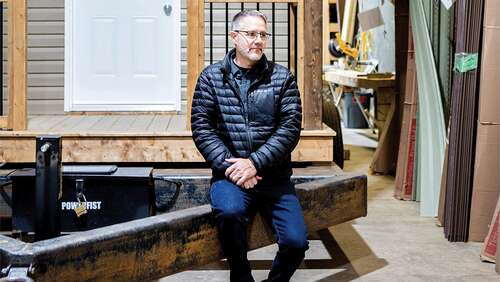
12 Neighbours founder Marcel LeBrun at the 12 Neighbours warehouse. (Photography by Chris Donovan)
Al Smith met Chanda Woodworth in his early 50s, after he moved to Fredericton in 2016. He hadn’t expected to fall in love again, and he hadn’t planned on ending up in Fredericton at all. Smith was still grieving the death of his wife from cancer the previous summer, and had headed east from Hamilton, Ontario, to take care of his elderly father. But as soon as a mutual friend introduced Smith and Woodworth, the two clicked—and moved in together—immediately.
Smith, who wears sunglasses after a stroke left him with nerve damage, hadn’t worked since he quit his job in waste disposal to look after his wife when she was sick. Woodworth was also unemployed when the couple were looking for a place to live, so their housing options were limited. First, they tried a rooming house, and later, a subsidized apartment in a building downtown. It was a cozy setup, but it didn’t last: the building’s owners soon eliminated its subsidized units, forcing their tenants out. For the next six months, Smith and Woodworth occupied a bathroom-less pop-up camper, parked on a friend’s property. With no stove for heat, the friend’s cat slept on Smith’s chest to keep him warm through the cold, damp nights.
Smith’s sister gave the couple what little cash she had to rent a room in a local motel, but the place was mired in chaos. One resident died and another locked themselves in their room and set a mattress on fire. Smith couldn’t believe he was living there. He didn’t feel especially unlucky. He just couldn’t figure out how to rally after being kicked down so many times.
During the height of Smith’s hopelessness, he stumbled upon a news article about 12 Neighbours, a planned community of tiny homes on the north bank of the Saint John River. Designed to get the city’s growing unhoused population off the streets—with very few strings attached—the miniature town was the brainchild of Marcel LeBrun, a software engineer turned multi-millionaire. According to the article, LeBrun had channelled his nerdy affinity for problem-solving (and his spectacular wealth) into a subsidized, shelter-centric social enterprise. Smith had never heard of tiny homes before—or the middle-aged rich guy who’d graciously committed to funding 99 of them—but he certainly saw LeBrun’s radical idea as a solution to his own housing crisis. “I said to Chanda, ‘It’s going to be like winning the lottery getting into there,’ ” Smith recalls.
In the winter of 2022, Smith and Woodworth finally got the win they needed. The couple moved into the third home built by the 12 Neighbours team. They’re just two of dozens of people LeBrun’s project has helped back onto their feet in the last two years. In that time, LeBrun’s gargantuan act of altruism, channelled so efficiently into diminutive 240-square-foot homes, has raised questions about what the country’s policy-makers might learn about how to rectify its housing woes from one man with deep pockets—one who stepped in where the government has failed.
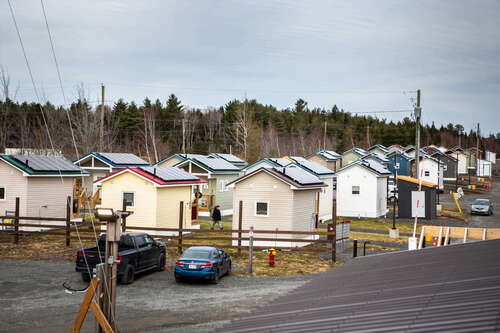
The tiny home community in Fredericton, NB
In the age of Musk, Zuck and Bezos, Marcel LeBrun is a palate-cleansing tech magnate. He rebuffs the more-is-more mentality of his peers, instead seeing his wealth as something of a fluke, something to spread around. “I won the parent lottery, the education lottery, the country lottery,” he says. “It would be arrogant to say every piece of my ‘success’ was earned, when so much of it was received.” LeBrun grew up in Cornwall, Ontario, a French-Canadian Catholic kid in a small Anglo town. His family moved to Moncton when he was 12. LeBrun’s father, Gilbert, an eyeglass maker, had a Grade 7 education and instilled in his son an appreciation for hard, and sometimes hands-on, work. When the basement needed a reno and the garage needed to be rebuilt, Gilbert enlisted a young Marcel, his eager apprentice, and they did the job themselves.
A self-described “gadget-y” kid with a love of Lego and electronics kits from RadioShack, LeBrun went on to study electrical and computer engineering at the University of New Brunswick, graduating in 1992. He landed on a career in software because he believed it was a powerful tool for solving seemingly unsolvable problems.
After graduation, LeBrun took work as an engineer at the telecom company NBTel (now Bell Aliant), figuring out how to stream video over the internet. (Years before the dot-com boom, this still seemed like a crazy idea.) LeBrun was soon invited to Ottawa to show off his research at a meeting with NBTel associate Terry Matthews, a Welsh-Canadian telecom millionaire. When Matthews learned of the potential applications for LeBrun’s work, he offered him money to start a new venture.
By the time LeBrun was 27, he was the CEO of iMagicTV Inc., a global leader in internet video–streaming software with $4 million in seed funding. When the French firm Alcatel acquired his company, LeBrun was promoted: he went from the head of a 200-person startup to vice-president of a 50,000-employee corporation. In 2006, he founded his next company, Radian6, whose specialty was social-media monitoring tools, allowing businesses to track conversations on then-burgeoning sites like Facebook, LinkedIn and Twitter. In 2011, at the age of 41, LeBrun sold Radian6 to Salesforce for US$326 million in cash and stocks. When I interviewed him late last year, he likened the sale to “winning the Stanley Cup of entrepreneurship.”
SIGN UP TO READ THE BEST OF MACLEAN’S:
Get our top stories sent directly to your inbox twice a week
Even after that blockbuster deal, LeBrun kept working: for a while, he stayed at Salesforce as a senior vice-president, then moved on to Real Ventures, a VC firm, and Potential Motors, an automotive software company. His windfall didn’t dramatically change his lifestyle. There were no superyachts, though he did treat himself to a $150,000 Nissan GT-R supercar and took racing lessons at a local track. (His Radian6 co-founders sprung for Porsche 911s.) Along with his wife, Sheila, and their kids, LeBrun moved into a new home within Fredericton’s city limits, one with 20 acres of land, which he reluctantly admits they did for a horse. Sheila, a retired occupational therapist, had long boarded Kokoro, her Canadian Curly, but always wished to see her munching on grass from the couple’s bedroom window. LeBrun didn’t feel particularly guilty about spending some of his money, but he did have a creeping sense that his newly enormous affluence could (and should) be used to chip away at some societal ills.
LeBrun’s philanthropic lightbulb moment came in 2015, while he was in Halifax for Inspire Justice, a social-justice event organized by the Canadian Baptists of Atlantic Canada. One of the speakers, Rick Tobias, ran the Yonge Street Mission in Toronto for 23 years—operating a food bank, a youth centre and employment programs. At the end of his prepared remarks, an audience member asked Tobias what advice he’d give to someone starting out in advocacy work. To LeBrun’s surprise, Tobias choked up. For all his efforts, Tobias had the sinking feeling that Canada’s poverty and homelessness problems were worse than ever. “My advice is: maybe you shouldn’t do all the things that we’ve been doing,” LeBrun recalls him saying. “Maybe you have to come up with some smarter approaches.”
For LeBrun, Tobias’s candour was intensely powerful—not just his willingness to share his accomplishments, but also the disappointments tangled up with them. After the event, LeBrun talked to his wife and his then 22-year-old daughter, Sharisse, about how he could do better, now that he had the time and money. LeBrun had watched tents go up on grassy patches in Fredericton’s core. There were so many people with no jobs and nowhere to go. He could have built another software company, but that didn’t interest him. And the idea of tackling homelessness didn’t seem all that different from launching a startup. “You’ve got a problem that you’re solving and barriers to overcome,” he says. “They’re not simple, but they’re intriguing.”
LeBrun began to investigate who or what in the world might serve as a model—help that actually helped. He tagged along to a weekly barbecue hosted by a friend in a low-income neighbourhood on Fredericton’s north side. LeBrun, who practically lived on an airplane during his Radian6 days, became a frequent flier once again. Over the course of a year, he visited non-profits across Canada and the U.S., and as far away as Ghana. He was particularly impressed by the Alex Community Food Centre in Calgary—an “anti–food bank,” per LeBrun. There was no means test for visitors to access meals, no visible delineation between volunteers and those who would otherwise go hungry. It was just a group of people cooking and eating together.
The most successful projects LeBrun encountered didn’t just tackle material deprivation; they also targeted a deeper kind of paucity. He visited Homeboy Industries in Los Angeles, a rehabilitation centre for former gang members. Many participants had criminal records, making it hard for them to re-enter the workforce or get an apartment—stabilizing aspects of a straight life. Homeboy offers an 18-month program focused on personal development and employability, plus 10 social enterprises, including a catering service and electronics-recycling program.
More than that, Homeboy gives participants a new way to see themselves as more than people who deserved to be dead or in jail. “I saw the power of purpose,” says LeBrun, “how a poverty of circumstances leads to a poverty of identity.” When it came time to nail down his own project, LeBrun ultimately landed on housing, persuaded by the “housing first” philosophy: the notion, supported by research, that putting people into safe, warm and proprietary places better sets them up to access other services. In a sea of need, shelter seemed like the best place to start.
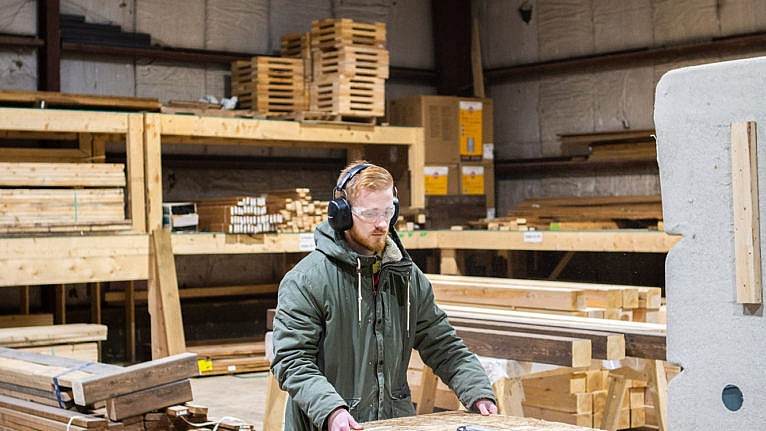
Homes are put together by a 19-person team of paid tradesworkers, some of whom are community residents. They now churn out one home every four days.
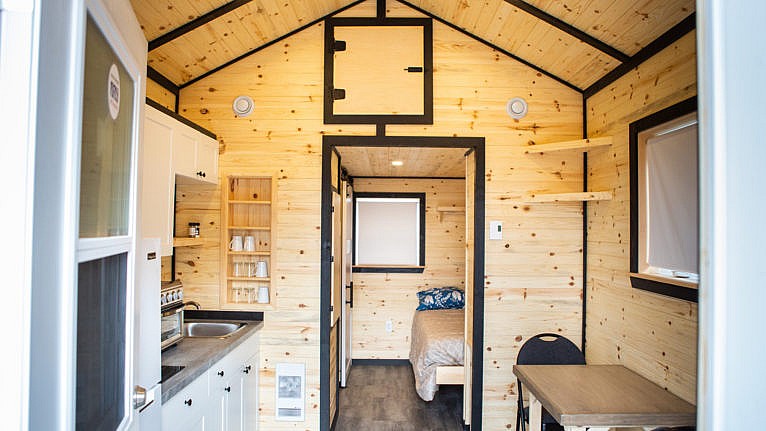
Each of 12 Neighbours’ 240-square-foot tiny homes is made in a massive, 8,000-square-foot donated warehouse.
Back in 2014, Fredericton’s population was roughly 60,000, with the number of chronically unhoused individuals hovering around 25. The following year, Fredericton’s Community Action Group on Homelessness published “The Road Home,” a plan to eradicate homelessness that included a fundraising blitz to build homes, mainly targeted at the local business community. (LeBrun wrote them a $35,000 cheque.) By 2020, however, the program hadn’t built a single home. According to LeBrun, the group ran into roadblocks, one of which was finding land.
Fredericton’s sluggishness in supplying sufficient, reasonably priced housing is, of course, a struggle common across Canada. Here’s some simple but devastating math: over the last two decades, the country’s average home price has increased by 218 per cent. During the same period, the average hourly wage increased by just 39 per cent to $34 per hour. The average rental price of a one-bedroom apartment across Canada now sits at $1,931, and the kind of eye-popping unaffordability once exclusive to cities like Toronto and Vancouver is seeping into once-sleepy suburbs and small towns.
Unconventional stopgaps have emerged. One is encampments: controversial, makeshift tent cities that have cropped up—and set off legal turf wars—in urban and suburban areas alike. Another solution is tiny homes, which provide basic refuge to society’s most vulnerable in the form of small amounts of highly subsidized square footage. The tiny-home movement, which originally popped up just after the subprime mortgage crisis as a way to reduce one’s environmental footprint and reject mass consumption, later spawned tons of Instagram-friendly lifestyle content, with influencers showing off high-design upgrades to their cozy abodes.
Lately, though, tiny homes have gained traction as low-cost antidotes for urban homelessness. Last January, the first residents moved into Winnipeg’s 22-unit Astum Api Niikinaahk—or “come sit at our home” in Michif, a Métis language—which has a medicine room, complete with drying sage. A long-awaited tiny-home community operated by Vancouver’s Lu’ma Native Housing Society was ready for occupancy as of last December. Nova Scotia also recently announced a pilot program of 52 tiny homes, to be built just outside of Halifax. The first tenants are slated to move in this coming summer.
Still, tiny-home projects can be controversial. As with encampments, shelters and safe-injection sites, neighbours sometimes worry about an uptick in crime and, occasionally, a hit to their own property values. In Hamilton, Ontario, a 25-cabin community planned for the city’s north end was nixed last October after setting off vicious infighting and threats of violence among advocates and city residents.
LeBrun settled on tiny homes—99 of them, to be exact—not because they were the cheapest option, but because he suspected they would give their residents a sense of ownership and dignity. He, too, encountered some early pushback, but of a different sort. Some Fredericton-based advocates were concerned that lumping dozens of previously unhoused people into a single, identifiable plot of land would lead to further ostracism. “They didn’t want people to walk by and say, ‘That’s where all of the formerly homeless people live,’ ” LeBrun says. “But those people couldn’t be more excluded in a tiny-home community than they were while living in tents.”
Once LeBrun focused his vision, he started tagging along with outreach workers who handed out sandwiches, water and information about supports in Fredericton’s tent pods. He asked residents whether they’d ever consider living in a tiny-home town. (All of them said yes.) The logistics of creating one weren’t simple, of course. LeBrun needed a plot of land big enough to accommodate a decent-sized community—close to necessary services, but sufficiently distanced from downtown to deter any interfering NIMBYism. He soon found a 65-acre plot, previously used for harvesting trees, for sale on the north bank of the Saint John River. It was on a major bus route and next to a plaza with big-box stores like Walmart and Canadian Tire, so residents would easily be able to pick up their groceries and prescriptions. The lot also backed onto a wooded area with trails, providing a much-needed sense of calm. LeBrun offered $500,000 to then owner Murray Munn, a forestry contractor—$50,000 below asking. When Munn heard about LeBrun’s plans for the site, he was so impressed that he made LeBrun an even lower counter-offer: $450,000.
After securing the land, LeBrun drew up a formal business plan and took it to the provincial and federal housing authorities. He was willing to foot roughly a third of the project’s estimated $12-million cost, but needed help with the remaining funding, plus municipal rezoning to expand the developable portion of the land. LeBrun, who describes himself as “not a big political guy,” says the process involved a lot of “arm wrestling.” When LeBrun applied to the Canada Mortgage and Housing Corporation for federal funding in July of 2021, he was told his application would take two weeks to process. The funding cleared 17 months later—after he’d already built 35 houses. “Our values were aligned, but they couldn’t move at the speed I planned to,” he says.
READ: My life in a tiny-home community
Right away, LeBrun sensed he’d need partners, not just to build 12 Neighbours but to sustain it. Some folks would be moving in with just the clothes on their backs. They’d need bedsheets, dishes and a broom to keep their new homes clean. As word of LeBrun’s project spread around tightly knit Fredericton, people reached out to ask what he needed. The Home Depot Canada Foundation gave LeBrun $75,000 to support any young-adult residents, while Omista Credit Union offered $15,000 for housing-supply kits, plus resources on financial literacy.
Various church groups stepped in with donations as well, the largest of which was the use of a cavernous, 8,000-square-foot space, which would later serve as 12 Neighbours’ manufacturing warehouse. LeBrun assembled his own 19-person team of carpenters and plumbers through online job postings and word-of-mouth, offering each worker a living wage of $20 to $30 per hour. The team went through two or three home prototypes before settling on its current 240-square-foot pine-and-metal model, outfitted with a bathroom, heating and solar panels. Construction kicked off in November of 2021, with each home finished on a trailer, then brought to the 12 Neighbours site fully intact.
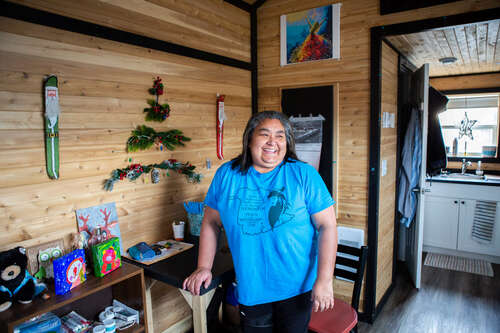
After some initial concerns about a tiny home triggering her life-long claustrophobia, Myrna Nash has found stability at 12 Neighbours. She recently enrolled at St. Thomas University to study Maliseet, the language of her ancestors. One day, she hopes to teach it.
Most of the people who populate the community came from Fredericton’s By Names List, an inventory of unhoused individuals registered with local federally funded service agencies. The list helps social service workers prioritize need in a system that clearly doesn’t have the resources to help everyone. A committee of non-profit workers and reps from New Brunswick’s Department of Social Development ultimately determines who would be a good fit for 12 Neighbours. LeBrun says that he recognizes many residents from his days canvassing tents.
The first of many move-in days arrived in January of 2022—for a couple who LeBrun met when they were living in the woods. “Heavy” is the one word he uses to describe the occasion. “Our focus is all about them when they move in,” LeBrun says, “but this one was also a little bit about us, you know? The joy of finally seeing somebody get in there.” LeBrun remembers watching the couple open their front door for the first time. For a while, the man lingered in the bathroom doorway, taking everything in. “Warm shower’s gonna be great,” he said.
***
I met LeBrun, now 53, at the 12 Neighbours lot last November, on a bright yet slushy day. Seventy-eight homes were finished, with 21 still to come. He was wearing a pair of faded jeans, a collared check shirt and a dusty fleece. In addition to writing cheques and petitioning for government assistance, LeBrun makes the 10-minute commute from his home to the lot more days than not, though he’s long since ditched his pricey Nissan for an electric Ford F-150. Working with marginalized people, he didn’t feel right rolling up in a $150,000 supercar. (He did, however, just get his pilot’s licence, and tools around in a two-seater Diamond Eclipse on weekends.) At the lot, he can be found directing contractors and immersed in long talks with residents. His family is involved, too. Sheila regularly checks on and goes for walks with community members. The couple’s 29-year-old son, Joshua, is director of operations.
LeBrun accompanied me around the premises, introducing me to residents, construction workers and staffers as we walked. The houses, broken up into short rows of 12 with a central pathway, are indeed tiny, though sturdy. Rent is kept at 30 per cent of income, which means that the vast majority of residents—many of whom rely on social assistance—pay a monthly max of $200, including all utilities and Wi-Fi. That’s less than a quarter of the average cost of a one-bedroom apartment in Fredericton.
When I stepped into a newly completed home, set to be occupied days later, I was hit with a blast of electric heat, instantly aware of how pleasant that might feel if you’d spent several Fredericton winters sleeping rough. The interiors vary slightly, but the layout is typically divided into a kitchen-slash-living space, a bedroom and a very small bathroom, with basic furnishings like a bed and a kitchen table, plus cutlery, cleaning supplies and towels. Each home also has a small porch, where residents can catch up with a friend, perhaps over a cigarette or two.
LeBrun realized early on that one of the challenges of providing stable housing would be when bad habits and unhealthy relationships followed new tenants into the community. Because 12 Neighbours was designed with a low barrier to entry, sobriety isn’t mandatory—though there is an addictions counsellor on staff—nor do staff expect that individuals living with trauma will always walk a straight line. There are a few rules, however: you must be relatively physically independent (there are accessible units), maintain control over your home and avoid creating an unsafe environment. When residents expressed concerns about safety, LeBrun hired a night guard and installed a security gate.
About four kilometres from that gate is the 12 Neighbours warehouse, where LeBrun drove me in his Ford. There, he introduced me to Randy Burtch, a contractor and resident, who was in the middle of adding skirting to an in-process home to keep drafts and critters at bay. Burtch moved from Ontario to New Brunswick in 1999; he says he liked its “down-home” vibe. Before that, he’d spent most of his life working in construction, picking up his first shovel when he was 10. When the pandemic kicked off, Burtch was in a relationship he already considered unsafe—his partner had struggled with substance abuse issues in the past. When she started using again, Burtch knew he had to leave, but COVID was rampant and he was out of work. Unable to find an affordable apartment, he moved into his car, parking it at the Walmart next to the future 12 Neighbours site.
For a year, Burtch spent much of his time in that car, even though the heater didn’t work. Still, he was pleasantly surprised by the generosity he encountered. Walmart employees would periodically bring him gift cards. A group of school bus drivers who parked nearby chipped in to help him fix his heater. And one day, after seeing Burtch’s car parked for a long period of time, LeBrun knocked on his window and offered him a coffee and an Egg McMuffin. LeBrun remembers that, when Burtch stepped outside to continue their conversation, he was shivering.
By February of 2022, LeBrun had helped Burtch snag one of his tiny homes, which Burtch describes as “tight but well-made,” a decent place to hang his Hank Williams posters. LeBrun also offered him a contracting gig. When he met Burtch, LeBrun thought he might be cognitively impaired, but after getting him out of his cold car, LeBrun quickly realized Burtch was simply in survival mode—and more than capable of holding down a job. Since joining 12 Neighbours, Burtch’s physical health has improved significantly. During my warehouse visit, he excitedly told me how he planned to spend his saved-up vacation time: on a trip to Scotland later this year, to indulge his interest in castles.
Back when LeBrun was doing his preliminary research for 12 Neighbours, a mentor told him that people who become homeless often run out of relationships before they run out of money—whether having to end a marriage that turned violent or vacating a home following the death of a loved one. This was the case for Susan Hayward. Originally from Lunenburg, Nova Scotia, she moved to New Brunswick in 2003 after meeting Kevin, who she soon married. They built their life around being a duo—plus a silver schnauzer named Zoey—in a small three-bedroom home. But in 2018, Kevin had to have his leg amputated, a complication from diabetes. Hayward worked minimum-wage custodial jobs before quitting to take care of Kevin full-time. When he died in 2018, she decided to sell their home. After paying the mortgage and settling her bills, the money from the sale had disappeared.
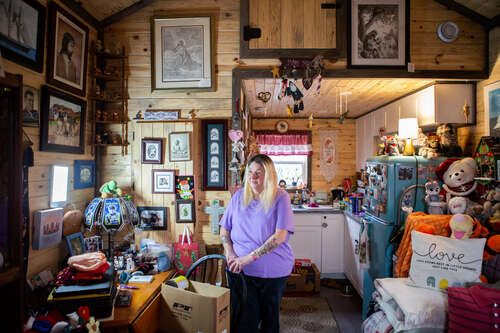
Susan Hayward and her faithful schnauzer, Zoey, moved into 12 Neighbours in October of 2022, after the death of Hayward’s husband. She’s since personalized every inch of her tiny home with stuffed animals, ceramic figurines and framed pictures of schooners, as well as her own paintings.
Hayward, now 57, says she floated between living situations after that, some of which were volatile. One friend struggled with mental illness, and her emotional states swung rapidly between highs and lows. In the fall of 2022, on the eve of Hurricane Fiona, the friend’s sister kicked Hayward out. She spent a week in a shelter before getting a call about a spot at 12 Neighbours. “I cried when I heard,” she says. “It was like God had been looking after me every step,” she says. Hayward used Kevin’s shirts to make cases for the pillows that line her daybed. Zoey, now a senior pup, alternates between two beds on the floor, often begging for cheese.
With 12 Neighbours, LeBrun’s intention isn’t to simply throw cash at Canada’s homelessness problem. (He hasn’t loaned residents money, though he says some of them have asked.) His ultimate goal is to create an environment where transformations, like those of Burtch and Hayward, are possible. Community members, the vast majority of whom live solo, range in age from 18 to 70, highlighting how quickly—and for how long—people can fall through the cracks. “We have people who have been run over by trauma, by substance abuse, by all of these things,” he says. “It’s about excavating that person, buried under their circumstances, little by little.”
That desire to build self-sufficiency, even for the residents who remain on social assistance, underpins a much bigger project currently in development: a $3-million, 12,000-square-foot social enterprise centre to boost 12 Neighbours’ community space and employment opportunities for residents and at-risk youth elsewhere in Fredericton. The two-storey complex—which will house a large café with a pizza oven and a smoothie bar, a teaching kitchen and event and classroom space—is set to be completed by this spring.
READ: Why an Ontario city is now permitting homeless encampments and tiny homes in parks
For now, 12 Neighbours residents can take part in its on-site personal development groups, which help them set goals, like earning GEDs, then track their progress. Some have found work at a pop-up coffee shop, located in a nearby craft brewery, and a print shop that sells, for lack of a better word, merch, like 12 Neighbours–branded sweatshirts, T-shirts and tote bags. There have been more than enough moments of tangible progress to convince LeBrun that 12 Neighbours’ approach is working. “A lady who works in our print shop always says, ‘I’m walking with my head up,’ ” LeBrun says. “She knows she has something to contribute. It takes people a long time to believe that.”
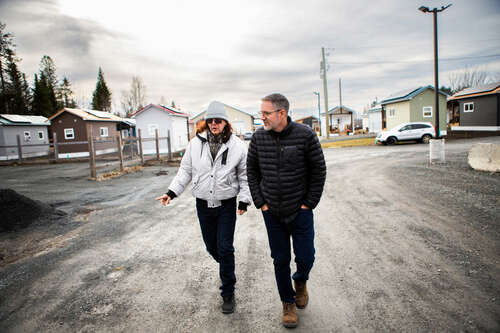
Al Smith (pictured left) and his girlfriend, Chanda Woodworth, lived in a few unstable housing situations—like a pop-up camper and a chaotic motel—before landing at 12 Neighbours in 2022. Smith now appears alongside LeBrun (right) in regular video updates about the community’s construction progress.
When I finally met Al Smith, who was donning his trademark sunglasses, he was keen to play the role of tour guide. He told me that living at 12 Neighbours had helped him find confidence. When he and Woodworth first moved in, LeBrun hired Smith to do odd jobs, like building picnic tables, but his true calling emerged over time. LeBrun regularly films and posts video updates in which he tracks the community’s progress toward its 99-home goal. One day, Smith filmed a video in his place. In a short clip from March of 2022, Smith stands close to the camera as he introduces house number eight. These days, LeBrun and Smith deliver updates as a pair.
In a video update from October of 2022, Smith had another co-star: Kate Rogers, the mayor of Fredericton, who meets Smith for coffee from time to time as part of her regular outreach efforts. “My meetings with Al have been important, because he’s telling me about that experience as it’s lived on the ground,” Rogers says. Smith’s role as de facto community ambassador comes with its share of perks, too. When 12 Neighbours was recently honoured as the designated charity at a Honeymoon Suite concert at the Fredericton Playhouse, LeBrun sent Smith and Burtch as his emissaries. It gave them the chance to enjoy VIP backstage passes, plus a boost from being treated, even briefly, like big shots.
***
Not everyone who has found their way to 12 Neighbours gets a fresh start. A few residents have been kicked out for violent behaviour. Two have died—one from cancer and another under unclear circumstances. Despite the losses, LeBrun was glad that his project was able to get each of these men off the streets, even for a short time. One had reconciled with his family, thrilled at the prospect of a second chance. “In some ways I felt like, ‘What a positive place to end his days, compared to what would’ve happened to him in another context,’ ” LeBrun says. Some 12 Neighbours residents prefer to keep to themselves, but LeBrun has managed to develop close connections with many others—“friends with boundaries,” he calls them, mindful that he’s fundamentally their landlord.
Rick Tobias died in 2022, but the questions he inspired are still relevant: are things better in Fredericton than before LeBrun’s team broke ground? Has their help really helped? Ambitious as it is, 12 Neighbours—now home to roughly 80 residents and a warehouse that cranks out a tiny home every four days—has barely put a dent in Fredericton’s ongoing homelessness problem. Recently, there were more than 8,000 entries on the waitlist for affordable housing in New Brunswick. A project like 12 Neighbours, with such a determined central personality, hasn’t yet proven easy to replicate. The province could use 80 LeBruns. Canada could use many more.
READ: Cities will learn to live with encampments
To date, LeBrun and Sheila have poured roughly $4.5 million of their own money into 12 Neighbours, not to mention thousands of days. In a way, the tiny-home community is the ultimate luxury he’s purchased with his Salesforce millions—a true passion project, something he can tinker with in service of a greater good. “You know when you’re in school and someone asks you, ‘If you could do anything you want when you grow up, what would it be?’ ” he says. “That’s a fun question when you’re in school, but a really hard one in reality. It’s a privilege that I get to do this.”
As my tour of the 12 Neighbours property wound down, a man who appeared to be in his thirties approached LeBrun and me near the parking lot. He was wearing doubled-up sweatshirts, hoods pulled tightly around his face, and carrying nothing more than a backpack and a plastic bag. He told us his story: he’d just arrived from Ontario. He didn’t have a cellphone. He’d spent several nights at a shelter, but staff kicked him out when they learned he wore adult diapers. He had nowhere to live, but someone told him about 12 Neighbours. He wanted to know how he could live there.
LeBrun didn’t send the man along to an administrator. He didn’t tell him to come back the next day. Instead, LeBrun asked him where he was currently spending his nights to confirm his eligibility. He explained that the man would need to get on the By Names List, recommending that he speak with a social worker at a specific clinic downtown. The visitor’s hope seemed to collapse a little upon hearing the hurdles he’d need to clear in order to be housed. Undaunted, LeBrun didn’t look like an altruistic multi-millionaire with a big-picture vision in that moment. He looked like any one of thousands of full-time outreach workers across the country, patiently explaining the options, their hands shoved in their pockets against the cold.
This story appears in the March issue of Maclean’s. Subscribe to the magazine now.



